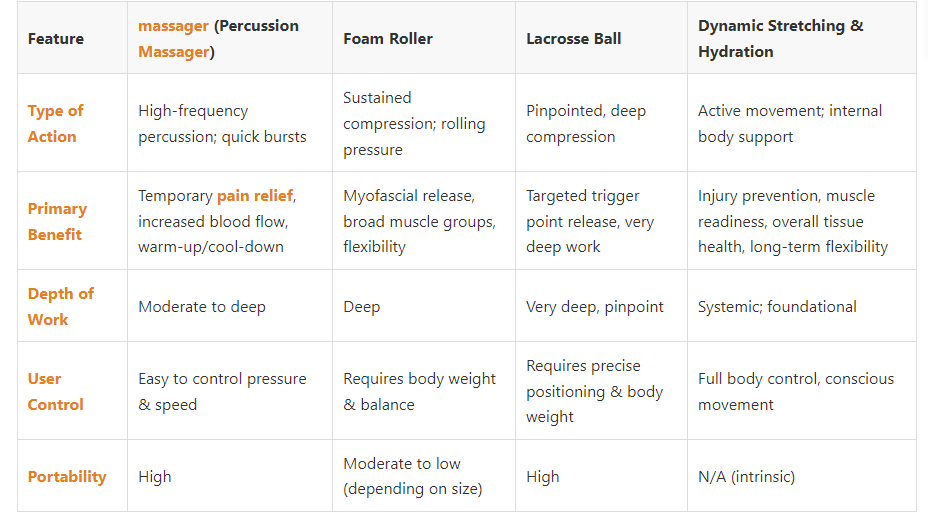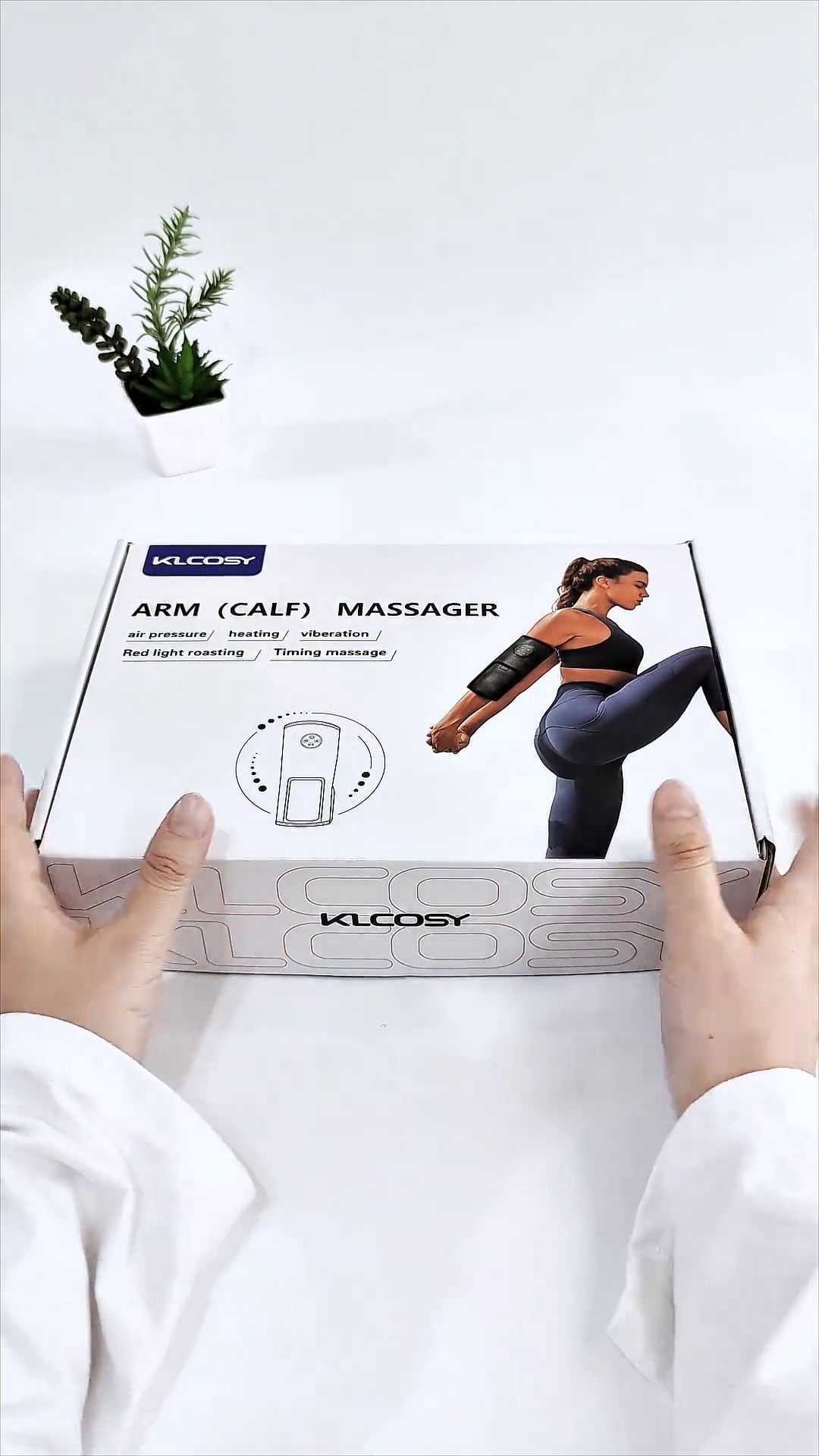Do Massage Guns Help Desk Pain? Expert Insights
- By Tony
- Updated on
You've likely seen them everywhere: in gyms, on social media, wielded by athletes, promising rapid recovery and blissful pain relief. We're talking about the ubiquitous massager, a percussive therapy device that's become a staple in many fitness enthusiasts' arsenals. But amidst all the hype, a crucial question arises: are these devices truly a game-changer for muscle recovery and overall well-being, or are they just another gadget promising more than it can deliver? As someone deeply involved in understanding user needs for portable massager devices and guiding individuals towards holistic wellness, I believe it's important to cut through the noise and explore what makes a massager effective – or perhaps, what its limits truly are. My goal here is to provide a balanced perspective, helping you decide if adding a deep tissue massager to your routine is the right move for your personal fitness journey.
What Happens When Muscles Ache? Understanding Post-Workout Pain
Have you ever felt that familiar stiffness and soreness a day or two after an intense workout or a long trail run? That, my friend, is likely Delayed Onset Muscle Soreness, or DOMS. It's a common experience for fitness enthusiasts, characterized by tenderness, reduced range of motion, and muscle stiffness. DOMS isn't caused by lactic acid buildup, as once commonly believed. Instead, it results from microscopic tears in muscle fibers and the subsequent inflammatory response as your body works to repair and rebuild them, making them stronger. This natural repair process is essential for adaptation and growth, but it can certainly be uncomfortable.
Beyond DOMS, muscles can also develop "knots" or trigger points – hyperirritable spots within a taut band of skeletal muscle. These can limit movement, cause localized pain, and even refer pain to other areas of the body. For an active individual, especially a dedicated runner, addressing these areas of tension is paramount for maintaining performance, preventing injury, and ensuring overall comfort. Traditional methods of addressing this involve hands-on massage and pain relief techniques, but now the world has shifted to self-application. Understanding the underlying causes of muscle discomfort is the first step in finding effective solutions.
- Microtrauma: Intense exercise causes tiny tears in muscle fibers.
- Inflammation: The body's natural response to repair these tears.
- Metabolic Waste: Byproducts of energy metabolism accumulate, contributing to soreness.
- Nerve Sensitivity: Pain receptors become more sensitive in affected areas.
- Trigger Points: Localized areas of muscle spasm and tenderness.
The Science Behind Percussion Massage: How a Deep Tissue Massager Works
A massager operates on the principle of percussive therapy. This means it delivers rapid, repetitive strokes deep into the muscle tissue, essentially "pounding" the muscle. This isn't just random vibration; the percussive action aims to penetrate beyond the superficial layers, targeting deeper muscle fibers and fascia, which is the connective tissue surrounding your muscles. The mechanical force, typically ranging from 1,200 to 3,200 percussions per minute, serves several key physiological purposes that contribute to muscle relaxation and pain relief.
Firstly, the rapid pulsations increase blood flow to the targeted area. Enhanced circulation brings more oxygen and nutrients to the muscles while simultaneously helping to flush away metabolic waste products that contribute to soreness. Think of it like jump-starting a sluggish stream into a flowing river! Secondly, the high-frequency vibration can help desensitize the muscle fibers and nerve endings, effectively disrupting pain signals sent to the brain. This is why you often feel immediate, temporary pain relief – the device is essentially distracting your nervous system from the discomfort. Lastly, percussion can aid in breaking up adhesions and increasing the elasticity of muscle fibers and fascia, promoting greater flexibility and range of motion. It's truly fascinating how a small device can generate such profound effects.
- Increased Blood Flow: Delivers oxygen and nutrients, removes waste.
- Pain Signal Disruption: High-frequency vibrations override pain perception.
- Muscle Relaxation: Reduces tension and spasms.
- Fascial Release: Helps break down adhesions in connective tissues.
- Improved Range of Motion: Enhances flexibility and joint mobility.
Beyond the Buzz: Real Benefits of Using a massager
When it comes to recovery, many fitness enthusiasts are seeking a magic bullet. While a massager isn't quite that, it certainly offers tangible benefits that make it a valuable addition to your recovery routine. The primary and most immediately noticeable benefit is often temporary pain relief and muscle soreness reduction. After a tough workout, spending a few minutes with a massager can significantly ease that tight, achy feeling, allowing you to move more freely and comfortably. This immediate relief can be incredibly motivating for consistent training.
Beyond just feeling good, using a massager can contribute to improved flexibility and range of motion. By working on tight muscles and fascia, the device helps to loosen up tissues that might be restricting your movement. This is particularly beneficial for trail runners or anyone engaging in activities requiring dynamic movement. Furthermore, incorporating a massager into your warm-up can help prepare your muscles for activity by increasing local blood flow, while using it during cool-down can aid in the recovery process by promoting circulation and relaxation. It's like having a quick, accessible personal therapist whenever you need one. However, it's crucial to remember that these benefits, while significant, are largely for temporary relief and acute issues, not a complete long-term solution for chronic conditions or underlying biomechanical issues.
- Pre-Workout Activation: Primes muscles and increases blood flow before exercise.
- Post-Workout Recovery: Reduces DOMS and speeds up the removal of metabolic byproducts.
- Enhanced Flexibility: Improves joint range of motion by loosening tight muscles.
- Targeted Relief: Pinpoints specific knots and tension areas.
- Accessibility: Offers convenient self-massage anytime, anywhere.
Tools in the Recovery Toolkit: Comparing massagers, Foam Rollers, and Stretching
Here's where the perspective of an experienced wellness guide really comes into play. While a massager is undeniably useful, it's just one tool in a comprehensive recovery toolbox. Many experienced runners and physical therapists will tell you that for true deep tissue massager work, especially to break down stubborn adhesions and achieve sustained pressure, foam rollers and lacrosse balls are often more effective. These tools allow you to apply consistent, deep pressure to a broad area (foam roller) or a very specific point (lacrosse ball), enabling sustained myofascial release that a percussive device might not fully replicate. It's like comparing a quick hammer drill to a slow, steady press – both have their place.
Moreover, we absolutely cannot overlook the foundational elements of recovery: hydration and dynamic stretching. To be honest, these are arguably even more important than any tool you might use. Adequate hydration ensures your cells function optimally, including muscle repair, and helps maintain the elasticity of your tissues. Dynamic stretching, performed before a workout, prepares your muscles for movement and improves your range of motion, significantly reducing injury risk. After your activity, static stretching helps to lengthen muscles and improve flexibility. Without these fundamental practices, even the best massager or foam roller will struggle to provide lasting benefits. Recovery is truly a holistic endeavor, not just about one gadget.
Table: Recovery Tool Comparison for Fitness Enthusiasts

Mastering Your Massager: Tips for Effective and Safe Use
So, you've decided a massager has a place in your routine – fantastic! But knowing how to use an electric massager effectively is key to maximizing its benefits and avoiding any potential issues. First, always start with the lowest setting and gradually increase intensity. Your muscles need time to adjust. Glide the massager over the muscle, avoiding bony areas, joints, and tendons. For areas of tension, you can hold it for about 15-30 seconds, allowing the percussion to work its magic. Remember, this isn't about brute force; it's about consistent, targeted application. Gentle, rhythmic strokes are often more effective than simply pressing hard.
A common concern I hear is, "Can electric massagers cause nerve damage?" This is a really, really important question. While rare when used correctly, improper use can lead to discomfort or, in extreme cases, nerve irritation. To avoid this, never use the device directly on nerves that run close to the surface, such as those behind your knee or in your neck. If you feel numbness, tingling, or sharp pain, stop immediately. Think of your deep tissue massager as a precision tool, not a blunt instrument. Listen to your body – it's the best guide you have. And always, always read the user manual that comes with your specific massager for detailed instructions and safety warnings.
- Start Slow: Begin with the lowest setting and gradually increase intensity.
- Glide, Don't Press: Move the massager gently over the muscle, letting the percussion do the work.
- Target Muscles, Avoid Bones: Keep the device away from joints, bones, and tendons.
- Limit Duration: Use for 15-30 seconds per muscle group, and generally no more than a few minutes total per session.
- Listen to Your Body: Stop if you feel any sharp pain, numbness, or discomfort.
- Hydrate: Drink plenty of water before and after use to aid muscle recovery.

When to Seek Professional Help and Why it Matters
While a personal massager can be incredibly beneficial for everyday aches and recovery, it's not a substitute for professional medical advice or treatment. If you experience persistent or worsening pain, severe swelling, numbness, weakness, or suspect a more serious injury, it's crucial to consult a healthcare professional, such as a doctor, physical therapist, or sports medicine specialist. They can accurately diagnose the issue and recommend an appropriate course of treatment. Self-treating a serious injury with a massager could potentially delay proper diagnosis and recovery.
Moreover, if you have certain medical conditions, such as deep vein thrombosis, severe osteoporosis, or are pregnant, or have any open wounds or recent surgeries, you should avoid using a massager or consult your doctor before doing so. It’s also wise to get professional guidance on how to properly perform certain stretches or use other recovery tools, especially if you’re new to intense physical activity. My mission, as a wellness guide, is to empower you with tools, but also with the wisdom to know when to seek expert help, ensuring your journey towards better health is both effective and safe.
Ultimately, massagers are a fantastic complement to a well-rounded recovery strategy. They offer quick, targeted relief, aid in warm-up, and enhance post-activity recovery for busy fitness enthusiasts. However, they are most effective when integrated into a lifestyle that prioritizes hydration, proper nutrition, varied stretching, and, when necessary, professional guidance. Embrace these tools, yes, but also embrace the broader principles of wellness. Your body, as an incredible machine, deserves a truly comprehensive approach to care. Consider our range of portable massager devices designed for effective deep tissue massager work and enhanced massage and pain relief, crafted to support your active life.




